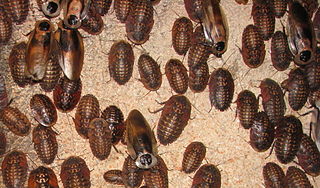
Giant cockroaches, or blaberids, are the second-largest cockroach family by number of species. Mostly distributed in warmer climates worldwide, this family is based on the American genus Blaberus, but much of the diversity is also found in Africa and Asia.

The family Phylliidae contains the extant true leaf insects or walking leaves, which include some of the most remarkably camouflaged leaf mimics (mimesis) in the entire animal kingdom. They occur from South Asia through Southeast Asia to Australia. Earlier sources treat Phylliidae as a much larger taxon, containing genera in what are presently considered to be several different families.

The Euphasmatodea, also known by its junior synonym Verophasmatodea is a suborder of the Phasmatodea, which contains the vast majority of the extant species of stick and leaf insects, excluding the Timematodea. The oldest record of Euphasmatodea is Araripephasma from the Crato Formation of Brazil, dating to the Aptian stage of the Early Cretaceous.

Phobaeticus is a genus of Asian stick insects comprising over 25 species. The genus includes some of the world's longest insects.
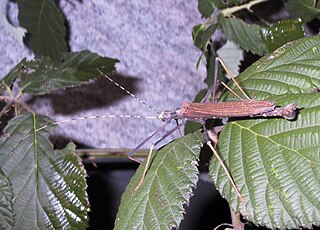
Pseudophasmatidae is a family of stick insect, in the suborder Verophasmatodea, commonly called the "striped walkingsticks". An important identifying characteristic is its mesothorax, which is never more than three times as long as the prothorax.
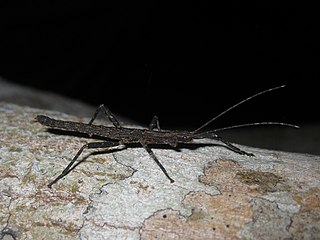
Malacomorpha is a genus of striped walkingsticks in the family Pseudophasmatidae. There are about 15 described species in the genus Malacomorpha.
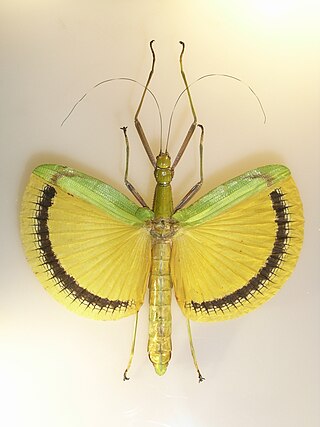
Necrosciinae is a subfamily of the stick insect family Lonchodidae, with its greatest diversity in South-East Asia.
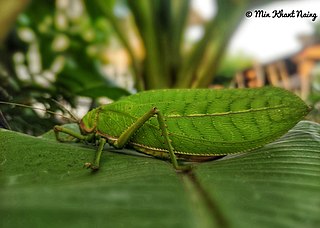
The subfamily Pseudophyllinae contains numerous species in the family Tettigoniidae, the katydids or bush crickets. Sometimes called "true katydids", together with the crickets of suborder Ensifera, they form part of the insect order Orthoptera which also contains grasshoppers.
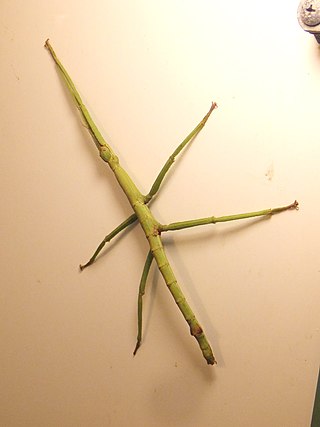
Pharnacia is a tropical Asian genus of stick insects in the family Phasmatidae and subfamily Clitumninae. Some species formerly placed in this genus have been reassigned to Phobaeticus.

Diapheromerinae is a subfamily of the stick insect family Diapheromeridae. They belong to the superfamily Anareolatae of suborder Verophasmatodea.

Bacillidae is a stick insect family in the order Phasmatodea and the suborder Verophasmatodea.

The Heteropterygidae is a family of stick insects belonging to the suborder Euphasmatodea. Species can be found in Australasia, East and Southeast Asia. About 150 valid species have been described.

Diapheromerini is a tribe of walkingsticks in the family Diapheromeridae. There are at least 30 genera Diapheromerini.

The Clitumninae are a sub-family of stick insects in the family Phasmatidae found in Asia. The type genus Clitumnus is now considered a synonym of Ramulus.

The Lonchodinae are a subfamily of stick insects in the family Lonchodidae found in: Australasia, Asia, Africa, Southern America and the Pacific.
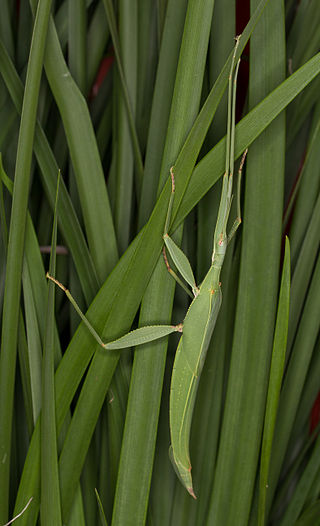
The Tropidoderinae are a sub-family of stick insects in the family Phasmatidae: genera are found in Africa, tropical Asia and Australasia.

The Platycraninae are an anareolate subfamily of stick insects in the family Phasmatidae. Their known distribution includes southern, southeast Asia and Australasia.

The Obriminae are the most species-rich subfamily of the Phasmatodea family Heteropterygidae native to Southeast Asia. It is divided into two tribe.

The Obrimini are the most species-rich tribe of the Phasmatodea family of the Heteropterygidae native to Southeast Asia.

Theramenes is a genus of medium-sized stick insects in the tribe Obrimini, which is native to the Philippines and to the Indonesian Talaud Islands.




















